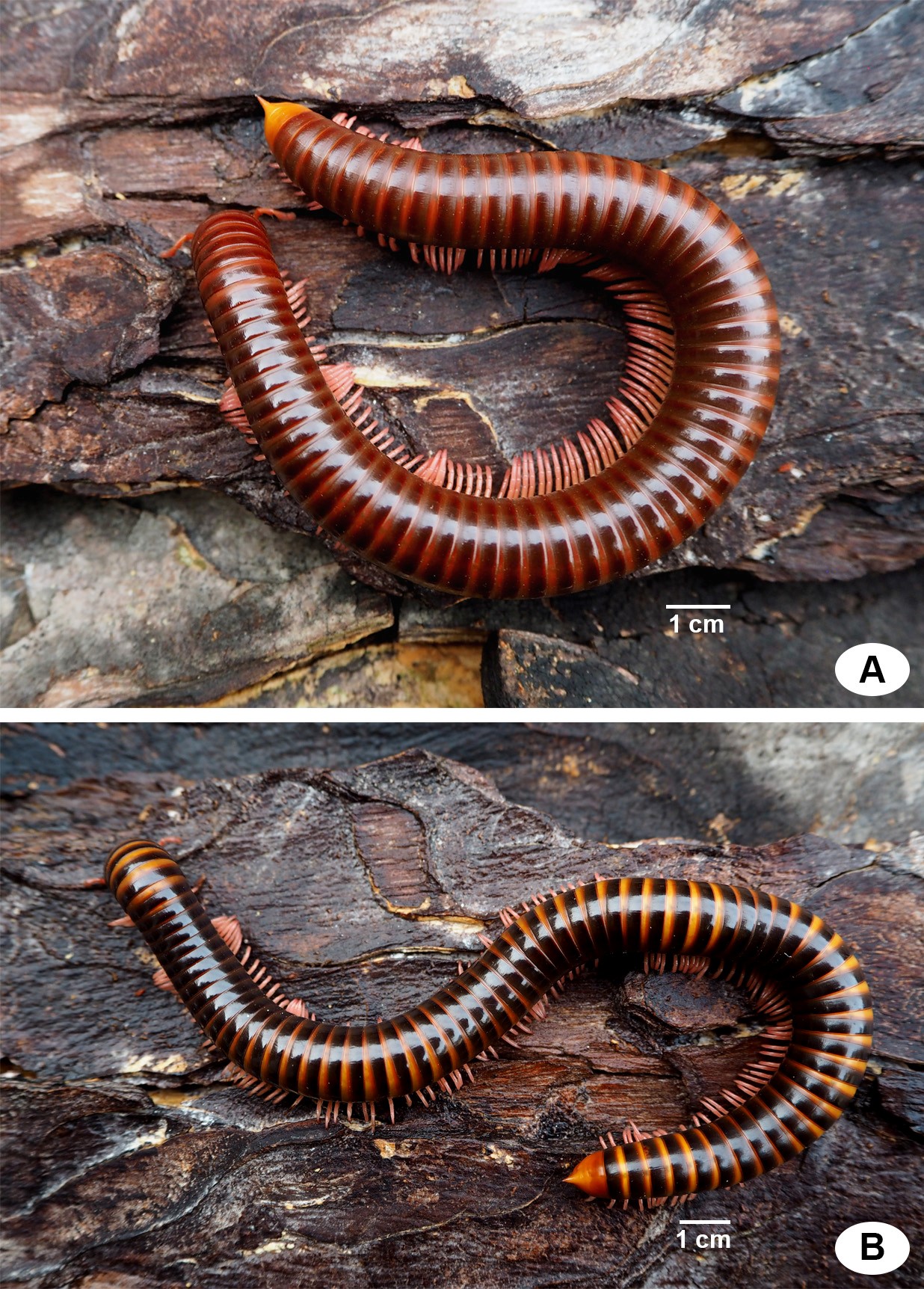Morphological and DNA Sequence Data of Two New Millipede Species of the Thyropygus induratus Subgroup (Diplopoda: Spirostreptida: Harpagophoridae)
DOI:
https://doi.org/10.58837/tnh.23.7.258818Keywords:
COI, gonopod, ThailandAbstract
The common cylindrical millipede genus Thyropygus (family Harpagophoridae) comprises four informal species groups, one of which is the T. allevatus group. This group is characterized by two synapomorphic gonopodal characters: (1) gonopods with tibial and femoral spines and (2) the tibial spine is very long and recurved proximad towards the femoral spine. The T. allevatus group is further divided into four subgroups: (1) T. allevatus subgroup, (2) T. opinatus subgroup, (3) T. induratus subgroup, and (4) T. cuisinieri subgroup. Based on gonopodal characters and COI barcoding, two new species of the T. induratus subgroup are described from Loei Province, Thailand, viz. T. panhai sp. nov. and T. somsaki sp. nov. The small uncate subterminal lobe (a hook-like process) at the basal part of the palette of the telopodite is the synapomorphy that assigns these two new species to the T. induratus subgroup. The two species are morphologically also well-differentiated from each other. In contrast, the COI data neither provide strong support for their placement in the T. induratus subgroup, nor provide strong support for their species level differentiation, since their interspecific COI divergence of 7% is at the borderline between the intraspecific divergences in T. induratus, T. uncinatus and T. resimus (5–6%, but with values of up to 12%) and the mean interspecific divergence within the T. induratus subgroup (12%; range: 7–15%). Hence, the taxonomic interpretation of T. panhai sp. nov. and T. somsaki sp. nov. as separate species within the T. induratus subgroup is, for the time being, almost entirely based on morphology.
References
Darriba, D., Taboada, G.L., Doallo, R. and Posada, D. 2012. jModelTest 2: more models, new heuristics and parallel com-puting. Nature Methods, 9: 772. https://doi.org/10.1038/nmeth. 2109.
Demange, J.-M. 1961. Matériaux pour servir à une révision des Harpagophoridae (Myriapodes – Diplopodes). Mémoires du Muséum national d’Histoire naturelle, Nouvelle Série, Série A, Zoologie, 24: 1–274.
Edgar, R.C. 2004. MUSCLE: multiple sequence alignment with high accuracy and high throughput. Nucleic Acids Research, 32: 1792–1797. https://doi.org/10.1093/nar/gkh340
Enghoff, H. 2005. The millipedes of Thailand (Diplopoda). Steenstrupia, 29: 87–103.
Folmer, O., Black, M., Hoeh, W., Lutz, R. and Vrijenhoek, R. 1994. DNA primers for amplification of mitochondrial cytochrome c oxidase subunit I from diverse metazoan invertebrates. Mole-cular Marine Biology and Biotechnology, 3: 294–299.
Hebert, P.D.N, Cywinska, A. Ball, S.L. and DeWaard, J.R. 2003. Biological identifications through DNA barcodes. Proceedings of the Royal Society London, B 270: 313–321. https://doi.org/ 10.1098/rspb.2002.2218
Hillis, D. and Bull, J. 1993. An empirical test of bootstrapping as a method for assessing confidence in phylogenetic analysis. Systematic Biology, 42: 182–192. https://doi.org/10.1093/sysb io/42.2.182
Hoffman, R.L. 1975. Studies on spirostreptoid millipeds. XI. A review of some Indonesian genera of the family Harpago-phoridae. Journal of Natural History, 9: 121–152. https://doi. org/10.1080/00222937500770101
Huelsenbeck, J.P. and Ronquist, F. 2001. MRBAYES: Bayesian inference of phylogeny. Bioinformatics, 17: 754–755. https:// doi.org/10.1093/bioinformatics/17.8.754
Jeekel, C.A.W. 2006. A bibliographic catalogue of the Oriental Harpagophoridae (Diplopoda, Spirostreptida). Myriapod Memoranda, 9: 5–58.
Miller, M.A., Pfeiffer, W. and Schwartz, T. 2010. Creating the CIPRES Science Gateway for inference of large phylogenetic trees. In ‘Proceedings of the Gateway Computing Environments Workshop (GCE)’, 14 November 2010, New Orleans, LA, USA. INSPEC, Accession Number: 11705685, pp. 1–8. https:// doi.org/10.1109/GCE.2010.5676129
Pimvichai, P., Enghoff, H. and Panha, S. 2009a. A revision of the Thyropygus allevatus group. Part 1: the T. opinatus subgroup (Diplopoda: Spirostreptida: Harpagophoridae). Zootaxa, 2016: 17–50. https://doi.org/10.11646/zootaxa.2165.1.1
Pimvichai, P., Enghoff, H. and Panha, S. 2009b. A revision of the Thyropygus allevatus group. Part 2: the T. bifurcus subgroup (Diplopoda, Spirostreptida, Harpagophoridae). Zootaxa, 2165: 1–15. https://doi.org/10.11646/zootaxa.2165.1.1
Pimvichai, P., Enghoff, H. and Panha, S. 2011a. A revision of the Thyropygus allevatus group. Part 3: the T. induratus subgroup (Diplopoda: Spirostreptida: Harpagophoridae). Zootaxa, 2941: 47–68. https://doi.org/10.11646/zootaxa.2941.1.3
Pimvichai, P., Enghoff, H. and Panha, S. 2011b. A revision of the Thyropygus allevatus group. Part 4: the T. cuisinieri subgroup (Diplopoda: Spirostreptida: Harpagophoridae). Zootaxa, 2980: 37–48. https://doi.org/10.11646/zootaxa.2980.1.3
Pimvichai, P., Enghoff, H. and Panha, S. 2014. Molecular phylogeny of the Thyropygus allevatus group of giant milli-pedes and some closely related groups. Molecular Phyloge-netics and Evolution, 71: 170–183. https://doi.org/10. 1016/j. ympev.2013.11.006
Pimvichai, P., Enghoff, H., Panha, S. and Backeljau, T. 2016. A revision of the Thyropygus allevatus group. Part V: nine new species of the extended opinatus subgroup, based on morpholo-gical and DNA sequence data (Diplopoda: Spirostreptida: Harpagophoridae). European Journal of Taxonomy, 199: 1–37. http://dx.doi.org/10.5852/ejt.2016.199
Pimvichai, P., Enghoff, H., Panha, S. and Backeljau, T. 2020. Integrative taxonomy of the new millipede genus Coxobolellus, gen. nov. (Diplopoda: Spirobolida: Pseudospirobolellidae), with descriptions of ten new species. Invertebrate Systematics, 34: 591–617. https://doi.org/10.1071/IS20031
San Mauro, D. and Agorreta, A. 2010. Molecular systematics: A synthesis of the common methods and the state of knowledge. Cellular & Molecular Biology Letters, 15: 311–341. https:// doi.org/10.2478/s11658-010-0010-8
Stamatakis, A. 2014. RAxML version 8: a tool for phylogenetic analysis and post-analysis of large phylogenies. Bioinformatics, 30: 1312–1313. https://doi.org/10.1093/ bioinformatics/btu033
Tamura, K., Stecher, G., and Kumar, S. 2021. MEGA11: Molecular Evolutionary Genetics Analysis version 11. Molecular Biology and Evolution, 38: 3022–3027. https://doi.org/10.1093/molbev/ msab120.
Xia, X. 2018. DAMBE7: new and improved tools for data analysis in molecular biology and evolution. Molecular Biology and Evolution, 35: 1550–1552. https://doi.org/10.1093 /molbev/msy 073

Downloads
Published
How to Cite
Issue
Section
Categories
License
Chulalongkorn University. All rights reserved. No part of this publication may be reproduced, translated, stored in a retrieval system, or transmitted in any form or by any means, electronic, mechanical, photocopying, recording or otherwise, without prior written permission of the publisher











